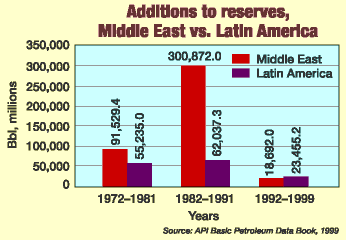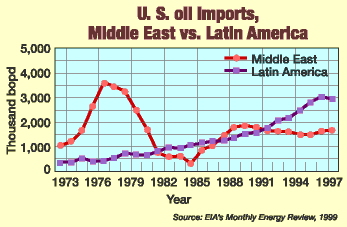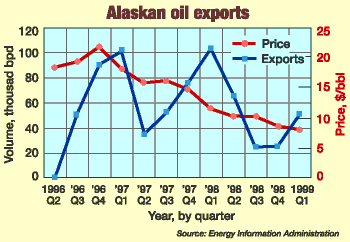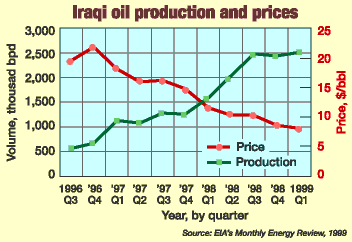U.S. energy policy contributed to lower oil prices
U.S. energy policy contributed to lower oil pricesClinton administration policies helped to swell global oil supplies far beyond world demand, depressing oil prices and driving numerous U.S. producers out of businessDr. A. F. Alhajji, Division of Economics and Business, Colorado School of Mines, Golden, Colorado
The most serious effect of the current energy policy is the depletion of oil reserves of U.S. allies (Venezuela and Mexico) while reserves of countries antagonistic toward the U.S. (Iraq, Iran and Libya) are maintained. Although many analysts believe that President Bill Clinton does not have an "energy policy," energy-related actions taken by his administration from 1993 onward constitute a "de facto energy policy." The difference between the "de facto energy policy" and the "declared energy policy" exists because of the influence of other foreign and domestic policies that have an impact (intended or not) on the energy industry, in general, and the oil industry, in particular. A foreign policy objective may override the "declared energy policy;" in other words, the U.S. State Department is making the "de facto energy policy." Five actions taken by the Clinton administration have led to lower oil prices, increased oil consumption, decreased fuel substitution, increased U.S. dependence on oil imports and the forcing of some independent U.S. producers out of the market. These actions include:
Diverting Investment by Imposing Embargoes Unsatisfied with embargoes imposed by the United Nations, the U.S. has imposed its own bans. Currently, embargoes are imposed on four oil-producing countries: Iraq, Iran, Libya and Myanmar (Burma). In addition to the UN embargo on Iraq, President Clinton signed the Iran-Libya Sanctions Act in August 1996, imposing mandatory and discretionary sanctions on non-U.S. companies that invest more than $40 million in Iran’s oil and gas sectors. The limit subsequently was lowered in 1997, to $20 million. On Aug. 19, 1997, President Clinton signed Executive Order 13059, reaffirming that virtually all trade and investment activities by U.S. citizens in Iran are prohibited. This order also banned any "contract for the financing of the development of petroleum sources located in Iran." Consequently, U.S.-based Conoco was obligated to abrogate a $550-million contract to develop Iran’s Sirri A and E offshore oil-and-gas fields. The U.S. lost a $1-billion trade deal despite the fact that the deal was legal. This order deterred some multinational companies from investing in Iran. In August 1996, Australia’s BHP Petroleum pulled out of a proposed $3-billion pipeline project to transport Iranian natural gas to Pakistan and India. On May 20, 1997, President Clinton issued an executive order prohibiting new investments in Myanmar (Burma). The prohibition includes any investment in the oil sector. However, it does not affect prior investments by American companies, such as Unocal. In addition to imposing sanctions, the Clinton administration has threatened to impose sanctions on Nigeria and Indonesia. The U.S. threatened to impose an oil embargo on Nigeria after the execution of nine human rights activists in that country on Nov. 11, 1995. These embargoes, and the threat of impending bans, have forced oil companies to invest in other regions of the world, such as Latin America, the North Sea and Central Asia. Because of these actions, oil companies have been hesitant to invest in many regions, fearing U.S. unilateral sanctions. According to the New York Times, oil executives and other industry experts say "the threat of unilateral economic sanctions has become big enough to cast a shadow over investment decisions stretching from Southeast Asia to West Africa to the Caspian Sea." Oil production from non-OPEC countries, especially Latin America and Norway, has increased substantially. This additional non-OPEC production has contributed to lower oil prices. In the 1980s, major additions to reserves came from OPEC members, particularly those in the Middle East. Conversely, in the 1990s, most additions to reserves came from outside the Middle East, Fig. 1. Between 1992 and 1999, additions to reserves in Latin America were 5.475 billion barrels greater than those of the Middle East.
Stimulating Latin American Output By 1992, U.S. oil imports from Latin America surpassed crude supplies from the Middle East, Fig. 2. Although this import shift could be the result of market forces, it would not have happened without a "green light" from the Clinton administration. The U.S. Department of Energy (DOE) acknowledged, through one of its reports, that politics have played a role in this import shift.
Support for increased Latin American oil imports is evident in a statement made by then-White House Press Secretary Mike McCurry on Oct. 12, 1997. He stressed the growing importance of U.S. dependence on oil from Venezuela and noted that, "It is a fact and it is an important fact ... the Middle East is a region that endured great conflicts." These comments conflict with the long-held U.S. policy of a "special relationship" with the Saudis. They also contradict a White House statement in February 1997 that declared Saudi Arabia, the largest Middle Eastern exporter of oil to the U.S. (at that time), a "secure, dependable and reliable oil exporter." Increased cooperation between the U.S. and Venezuela (well known for producing above its OPEC quota) was inaugurated by President Clinton’s visit to that country in October 1997. The two "Summits of the Americas" emphasized energy cooperation and resulted in the Energy Conference of the Americas in Norman, Oklahoma. Prior to the second summit, a smaller meeting of energy ministers and representatives from 26 countries of the Western Hemisphere was held in Caracas to prepare. Representatives signed a joint "Declaration of Caracas" that emphasized market integration and promotion of private investment. All these actions encouraged oil companies to invest in Latin America. Such investments led to more oil discoveries, more oil production and lower oil prices, Fig. 1. These changes prompted Venezuela to ignore its OPEC quota and increase its production. Allowing Alaskan Crude Exports In November 1995, the ban on Alaskan North Slope oil exports was lifted, followed by implementation in July 1996. Lifting the ban diverted crude from the U.S. to Asia, increasing American imports. Shifting some of the oil import share to Latin America lowered the demand for oil coming from the Middle East. Consequently, the Middle Eastern countries tried to find markets elsewhere, particularly in Asia. Unfortunately, they found Alaskan oil competing with their crude. The result was lower oil prices for everybody. Fig. 3 shows Alaska’s oil exports plotted against oil prices. It shows how oil prices started declining after the ban on Alaskan oil exports was lifted.
Implementing Iraq's Oil-For-Food Deal According to the UN’s oil-for-food deal with Iraq that began in December 1995, Iraq is allowed to sell up to $2 billion worth of oil every six months. The deal focused on the amount of money Iraq can earn without any mention of quantities. Then a cycle of declining oil prices and increasing production was set in motion, causing the Iraqi crisis to surface repeatedly. Oil prices declined even further when the UN doubled the amount of oil that Iraq could sell, increasing the sales figure to $5.2 billion, from $2 billion, every six months. Recently, there were calls at the UN Security Council to lift the embargo on oil sales. If Iraq was able to expand its capacity, oil prices would decline further in the same cycle described above. In fact, statistical testing confirmed this cycle. The effect of recent production cuts by OPEC members could be minimized, if Iraq is able to expand its capacity and increase oil production. The relationship between Iraq’s production and oil prices is visible in Fig. 4. Prices declined when Iraq’s production increased. Conversely, in April 1999, when oil prices exceeded the $18 level, OPEC cuts were accompanied by an Iraqi output decline caused by technical difficulties.
Institution of SPR Crude Sales On Jan. 16, 1991, then-President George Bush ordered the first emergency drawdown of the SPR, to minimize the oil price-raising effect of the Desert Storm military campaign. Filling the SPR has been an important component of world oil demand since its establishment in 1975. However, the process was stopped in 1995 as part of an effort to reduce the U.S. federal budget deficit. Because of the high cost of managing the SPR, the Clinton administration advocated selling some SPR crude. In 1996, the sale of SPR crude was begun in response to two legislated requirements — the Balanced Budget Down Payment Act and the Omnibus Consolidated Recessions and Appropriation Act of 1996. The sale continued in 1997 and early 1998, but it was canceled on May 11, 1998. This was because of low oil prices, exacerbated by the sale of SPR crude. The latter had led to decreased demand and increased supply. Many congressmen, senators and other government officials, including then-Secretary of Energy Federico Peña, objected to the sale. In summation, the policies of the Clinton administration — diverting investment into new regions by imposing embargoes; stimulating Latin American oil production; allowing Alaskan oil exports; and implementing Iraq’s oil-for-food deal — helped global oil supplies increase far beyond world demand. In response, oil prices fell through the floor and drove many U.S. producers out of business. The authors
Copyright © 1999 World
Oil |





 Dr.
A. F. Alhajji is an assistant professor and faculty
member at Colorado School of Mines’ Division of Mineral Economics. He earned MA and
Ph.D degrees in energy economics from the University of Oklahoma, Norman, in 1992 and 1995,
respectively. Before his tenure at Colorado School of Mines, he taught at the University of
Oklahoma. Dr. Alhajji has received numerous awards, including the Teaching Excellence Award
for 1998-1999. He authored the computer program, "PetroTrade." He is the author of
the forthcoming book, OPEC and the World Oil Market: An Alternative View.
Dr.
A. F. Alhajji is an assistant professor and faculty
member at Colorado School of Mines’ Division of Mineral Economics. He earned MA and
Ph.D degrees in energy economics from the University of Oklahoma, Norman, in 1992 and 1995,
respectively. Before his tenure at Colorado School of Mines, he taught at the University of
Oklahoma. Dr. Alhajji has received numerous awards, including the Teaching Excellence Award
for 1998-1999. He authored the computer program, "PetroTrade." He is the author of
the forthcoming book, OPEC and the World Oil Market: An Alternative View.
